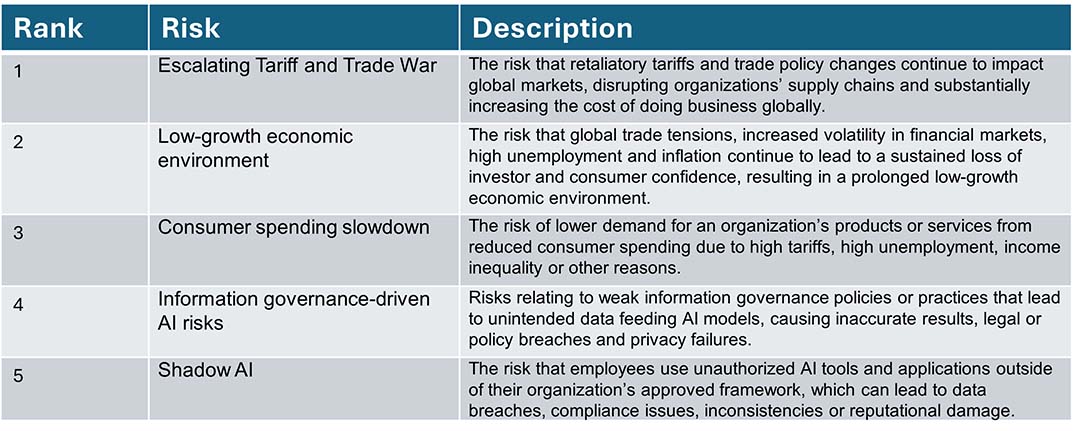The escalating tariff and trade war moved into the top rank of emerging risks for the second quarter of 2025, according to Gartner.
The Quarterly Emerging Risk Report series captures enterprise risk management (ERM) leaders’, risk management professionals’, auditors’, and senior executives’ views on emerging risks or over-the-horizon risk.
The 2Q25 report, based on a survey of 223 senior risk and assurance executives, also revealed mounting concern around the low-growth economic environment and consumer spending slowdowns, contributing to uneasiness about slowing global economy.
“The top five emerging risks in Q2 point to two broad themes for enterprises: A volatile low-growth macroeconomic environment, and a disruptive new technology that poses significant compliance risks rapidly growing in mainstream adoption,” says Gamika Takkar, director,: research, in the Gartner Risk & Audit Practice.
“Risk leaders need to ensure their organizations are prepared for potential disruption to supply chains and increases to the cost of doing business in a global market,” says Takkar. “These impacts have the potential to be more disruptive at a time of slowing global economic growth.”
AI-related information governance-driven risks, moved from the fifth most cited spot in 1Q25 to the fourth rank in Q2, and Shadow AI moved into the top 5 as the popularity and ease-of-access to public AI tools soars, and organizations face challenges in effectively monitoring its use.
Top Emerging Risks of Q2 2025

Source: Gartner (July 2025)
Prioritising cost optimisation
In the current environment, executive leaders are increasingly emphasizing cost optimization. However, cost-cutting measures that are rushed or poorly planned can also pose a risk to organizations.
“Executive leaders expect ERM to play a critical role by thoroughly evaluating how policy changes could affect organizational performance, risk exposure, internal controls, and overall business strategy,” says Takkar. “Half of executive leaders Gartner surveyed indicated that they depend on qualitative insights from internal teams, such as compliance and ERM to guide them.”
To effectively gauge the impact of cost-reduction strategies on operations, risk profile, key strategic initiatives and long-term growth, risk leaders should use qualitative assessment methods to evaluate actions. For instance, if delaying a key strategic initiative is a potential approach, take these three steps to fully evaluate the impact:
- Assess how changes affect strategic goals, short- and long-term business risk profile. Ask if delayed action adversely impacts a key strategic transformation that will sustain or create strategic value.
- Identify options to stay focused on key transformative initiatives. Consider the potential of collaborating with executive management to allocate resources or adjust other strategic goals to sustain an initiative that could be cut.
- Develop performance and strategic metrics to trigger adjustments to cost reduction. Consider whether a timely threshold trigger of market share or portfolio growth indicate revaluating a potential delay.
“Broad, rapid cost reductions that fail to consider their impact on both immediate and long-term risk profiles and strategic objectives may ultimately diminish efficiency and outweigh potential savings,” says Takkar. “Organisations that identify and manage risk actions will better protect their organization from current economic challenges.”
